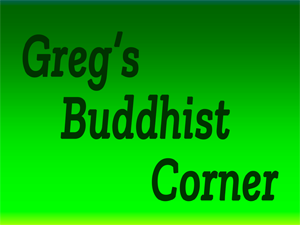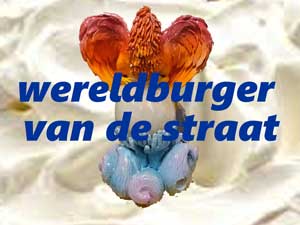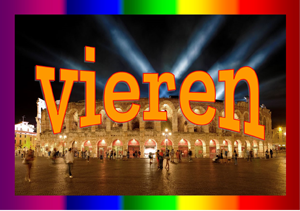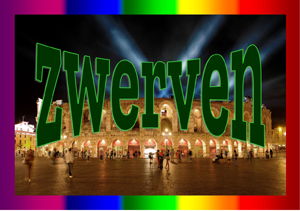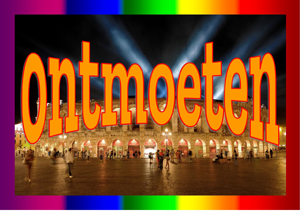With a drop of Mahamudra
QFWF no. 11, June 2019, based on the teachings of Geshe Sonam Ngodrup, Maitreya Instituut, May 2019, Loenen, Netherlands
By Greg Suffanti
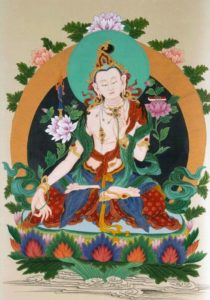
Buddhism has alternately been called “the religion of lists,” “not a religion at all, simply a philosophy,” and “a way of life more than a religion.”
In many ways, Buddhist ideals have crept so far into mainstream societies that we’re at the point where we’re beginning to have Buddhism without the Buddha, or secular Buddhism, appear as a viable alternative to traditional Buddhism in this age of spiritual rebellion and spiritual consumerism.
In today’s world, everyone is looking to have a “zen moment,” irrespective of any spiritual element or personal belief.
His Holiness the Dalai Lama speaks often about secular Buddhism, and I know he welcomes wholeheartedly this spiritual movement that does away with many of the traditional labels, beliefs and often complicated structural elements found within the Buddhist religion.
His Holiness’s wish is to benefit as many people as possible, and he emphasizes often that you don’t have to be a Buddhist to obtain some of Buddhism’s benefits.
The Buddha of Wisdom, Manjushri, can be practiced at home by anyone, Buddhist or non-Buddhist, and Geshe Sonam Ngodrup’s important advice for the home practitioner, or un-initiated, appears later in this article.

To the serious practitioner, Buddhism provides a stable, logical path to cultivating increasing states of happiness, up to and including the peerless state of Buddhahood or Enlightenment. You are never asked to believe in anything.
Furthermore, you can chart your own progress, so personal experience is your guide and positive growth is your fuel that allows your spiritual path to achieve its natural conclusion. Buddhism is about the possibility of bringing and then cultivating positive changes in one’s life in order to become as happy as possible.
To the serious practitioner, Buddhism is alive because of the lists, and because there are great beings who continue to propound the teachings and traverse the Buddhist path as living examples of the teachings themselves. People like His Holiness the Dalai Lama and Geshe Sonam Ngodrup.
Buddhism is alive today because the country of Tibet has preserved the Buddhist tradition, the Nalanda Tradition, in its entirety. Of course, with China’s occupation of Tibet, this means that most of the great masters now live in exile in India.
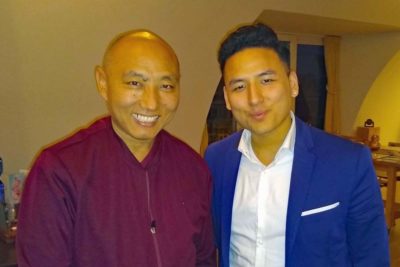
These great masters say all living beings possess the tathagatagarbha, or Buddha nature, and that it is possible to discover this truth within yourself if you know where and how to look.
“I have discovered this nectar-like wisdom,” Geshe Ngodrup often tells of the Buddha’s awakening, “but don’t know if I can find suitable vessels who will believe in or understand what I teach,” he says the Buddha lamented.
The Buddha was referring to emptiness, and it is through teachings and practices like White Manjushri and Mahamudra that an understanding of emptiness is cultivated and then finally realized.
Although I’ve had Tantric initiations for nearly twenty years, including multiple Wangs, or great initiations, in which the practitioner receives permission to visualize him/ herself as the Buddha/ deity being practiced, I’ve always been loathe to see myself, even in pretend, as a Buddha.
Although Geshe Ngodrup’s initiation was a Jenang, the other type of initiation, in which the practitioner (without having had a Wang), visualizes the deity above the crown of one’s head, I went to the initiation and retreat to answer a simple question: “Why do I want to see myself as a Buddha anyway?”
How do I keep my daily practice alive and meaningful?
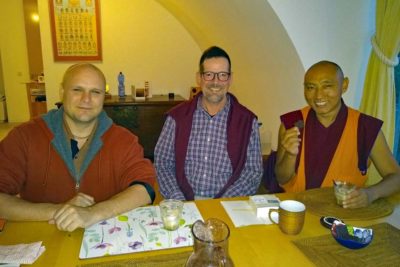
Also, this was the third time I was receiving the White Manjushri Jenang from Geshe la, so it begged the question, “how can I expand my daily practice of this deity?”
One of the challenges I always face is keeping my daily practice alive and meaningful, day after day, month after month, year after year, and decade after decade. It takes effort. And inspiration. I was hoping to be able to answer this question during my week’s visit to Maitreya Instituut in Loenen, in the very beautiful Veluwe forest of Gelderland Province in Holland.
Buddhism is about getting the most out of life. Geshe Ngodrup says, “you can rely on the advice of those who’ve been there. You don’t have to have been there yourself to rely on those who’ve set this out step by step like His Holiness the Dalai Lama, who after 50 years, talks about his many experiences.”
You need to have a big motivation, because it gets you further. Geshe Ngodrup compares it to university students, who he says, “all must do the same undergraduate study, but the PhD candidate has a different motivation from the beginning, and thus a different outcome.”
As Mahayana Buddhists, we’re looking to achieve the best outcome, both in this life and the next.
White Manjushri with a drop of Mahamudra
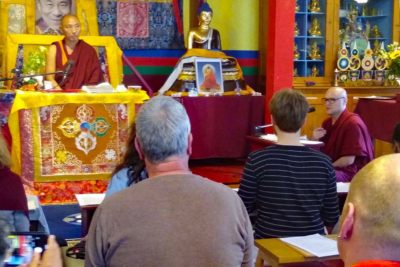
Canadian Buddhist monk, Ven. Khedrup, or Khedrup as he prefers being called, Geshe Ngodrup’s very personable and capable translator, told me that Geshe la pretty much made up the title of the retreat, “White Manjushri and a Drop of Mahamudra.”
So, if you’re looking for an historical reference, you may be in trouble. However, Mahamudra, Sanskrit meaning, ‘the great seal’, is about ultimate wisdom, or emptiness. Similarly, Manjushri is the Buddha of Wisdom, and the ultimate wisdom from the Buddhist perspective is emptiness, so the two topics are naturally and fundamentally connected.
Geshe Ngodrup taught from Panchen Losang Chokyi Gyaltsen’s “The Gelug/Kagyu Tradition of Mahamudra,” which is available as a free download from the Berzin Archives.
Geshe la also taught from “A White Manjushri Method” by Gyalwa Gendun Gyatso, which is available as a free download from the FPMT store.
The week-long initiation and retreat took place from Friday 10 May 2019 until lunchtime on the 16th. On the Saturday, Geshe la gave refuge and lay vows and an explanation of Kriya Tantra, or Action Tantra, and on the Sunday, he gave the White Manjushri Jenang, or permission to practice initiation.
In March of 2015 His Holiness the Dalai Lama gave a White Manjushri Empowerment which can been seen:
Dalai Lama gave a White Manjushree Empowerment, 2015
Tantra is often highly misunderstood. I hope the great love and simple clarity of Geshe Ngodrup’s teachings come through in this piece and that Geshe la’s teachings can be easily and correctly understood by the reader of this article. This shy, humble Tibetan Lama, with a moon-like golden face, explains why Tantra is so useful and today’s mind so perfectly suitable to becoming the Buddha of Wisdom, White Manjushri. As Geshe la is fond of saying, “if you understand the goal, you can practice joyfully.”
This article is a brief look at some of the highlights of the week. The private or secret parts of Tantra are not discussed in this article. Anyone wishing to take up either the White Manjushri or Mahamudra practices should thoroughly understand what they are undertaking. This article is not a substitution for the actual texts and sadhanas, but hopefully an illuminating glimpse at the often misunderstood world of Tantra.
Geshe Ngodrup: “We are the one that determines where we go”
“These teachings are aimed at transforming the mind. The practice of Dharma happens through subduing the mind. One is one’s own friend, or, one is one’s own enemy. Others can act as assisting conditions, but ultimately, it’s our own effort that’s needed. No enemy can send us to the lower realms, (i.e. Hell). Only we can accumulate the causes to go to a happy or suffering state. We are the one that determines where we go.”
“In the beginning we establish a motivation, which acts as a foundation for the activities which come later. All beings possess the tathagatagarbha, clear-light nature of mind, the luminosity of all things. If we are a Mahayana practitioner, then we need to cultivate and appreciate all sentient beings. His Holiness the Dalai Lama goes to temples and mosques and is always perfectly comfortable. There is never a reason to look down on others, their religion, etcetera. Regarding Manjushri, His Holiness the Dalai Lama says the Manjushri prayer has helped him ‘to remember and comprehend better.’”
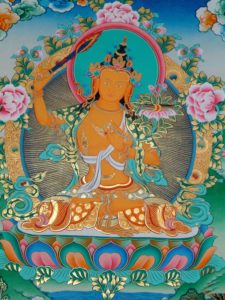
During the retreat, mantras were used for both Orange and White Manjushri. Geshe la explained that Orange Manjushri is the ‘common aspect’ of Manjushri and relates to general wisdom, while White Manjushri is the ‘uncommon aspect’ of Manjushri and relates to “the wisdom of recollection.”
Further, he said White Manjushri represented not only the traditional enlightened body, speech and mind of the deity, but enlightened activity as well. It should be noted that the White Manjushri sadhana does not use the orange Manjushri mantra.
Geshe Sonam Ngodrup gave the oral transmission of the White Manjushri mantra, Om VaKye Dam Na Mah – the mantra is pronounced “om wakey da ni ma” – and offered the following explanation:
Orange Manjushri mantra
|
Om |
Offering body, speech and mind. Transforming the ordinary into holy body, speech and mind. |
|
A |
All phenomena, or all Dharmas, are ultimately unproduced. |
|
Ra |
Uncontaminated by true existence. |
|
Pa |
Within the Two Truths (ultimate & conventional), the ultimate nature is the true nature and Is stainless. |
|
Ca |
There is no inherent existence. |
|
Na |
All phenomena are empty because they are dependent arisings and are merely labeled. |
|
Dhih |
Wisdom or knowledge base. |
We should approach with a joyful mind and think we’ll progress as best we can
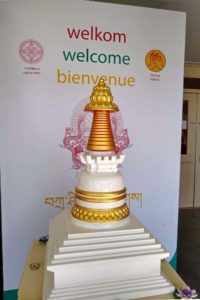
“We need to understand the ultimate sources of refuge. Similarly, if we can achieve this state, we can lead beings away from suffering and towards enlightenment. We should approach with a joyful mind and think we’ll progress as best we can. We should practice like the masters. Then, we can go from lifetime to lifetime with love and compassion, which are our fundamental nature. These sorts of practices help us to recognize these qualities within ourselves and then build upon this recognition.”
A Buddhist is an insider and can be determined by the view and by conduct
“A Buddhist is an insider and can be determined by the view and by conduct. The conduct is refuge. This is what makes a Buddhist. The door to liberation is refuge. The Four Dharma Seals are the view, and this is harder to establish than refuge.”
The Four Dharma Seals
- All compounded phenomena are impermanent
- All contaminated things are suffering
- All phenomena are empty and have no self
- Nirvana is peace
“Bodhicitta is what separates Theravada and Mahayana Buddhists.
We want to cultivate a stable refuge. There are three objects of refuge, the Buddha, the Dharma and the Sangha.
The main refuge is the Dharma Jewel itself, not the Buddha or the Sangha.”
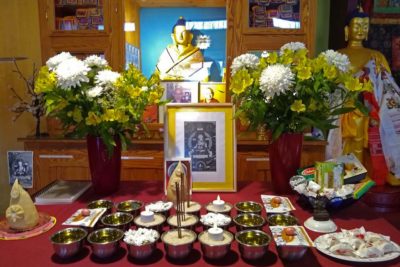
The Sangha consists of monks and nuns and the men and women who call themselves Buddhists. The Dharma are the teachings of the Buddha. So, in essence, you’re becoming an embodiment of the truth of the teachings, the actual Dharma Jewel, and this is what Geshe la always emphasizes.
Bodhicitta is the altruistic wish to achieve the greatest benefit of all others, with no exceptions. Geshe Ngodrup describes Bodhicitta as “a kind father who takes care of all his children.”
Theravada Buddhism emphasizes personal liberation. Geshe Ngodrup recommends spending an hour a day “developing positive mental qualities, reading and studying,” saying that this is a “great way to achieve the meditation topic.” “Stable effort can bring great results,” Geshe Ngodrup emphasizes.
Through the practice of refuge, we can achieve liberation
“We need to develop a conviction that the Three Jewels, the Buddha, Dharma and Sangha can help lead us out of samsara, or the suffering state. Refuge also protects us from harm from both humans and non-humans. On the basis of refuge all of one’s wishes can be fulfilled. Through the practice of refuge, we can achieve liberation. Through working for others, one’s own welfare is achieved. Through emphasizing the welfare of others, one’s welfare is naturally achieved.”
At this point Geshe Ngodrup gives the refuge ceremony for those who’ve not had it.
Everything is a preparation for highest Yoga Tantra
“Based on a steady Sutra practice our Tantric path will go better and easier. Specifically, we need to study Bodhicitta and emptiness.
There are four types of Tantra: Action/Kriya, Performance, Yoga, and Highest Yoga Tantra.
The practice of Sutra and the first three types of Tantra are all in preparation for Highest Yoga Tantra. The hand mudras are the same for the first three Tantras, but different for Highest Yoga Tantra because the offering goddesses have two hands for the first three, and four hands in Highest Yoga Tantra.”

In addition to the visualizations required when practicing the White Manjushri sadhana, the use of dorje and bell symbolizes the union of method and wisdom. Method and Wisdom are required to traverse the Buddhist path, and are often compared to the two wings of a bird, both of which are needed in order to be able to fly.
“Regarding the use of dorje and bell, it’s most important that you pick up the two together with one hand, because method and wisdom are practiced together. This is normally done with the right hand. Some Lamas say that the bell is then used with the left hand and the dorje with the right, and other Lamas teach just the opposite. Different Lamas teach different ways. The hand mudras are an ancient Indian custom that the Buddha adapted to help people collect merit.”
Buddhism separates itself by taking away a solid or permanent self
“His Holiness the Dalai Lama advises to make emptiness the core of your practice. This way you are directly countering your afflictions like anger and attachment. The ignorance grasping at a solid and permanent self is the root of all our afflictions and suffering. Buddhism separates itself by taking away a solid self, which also shows the meaninglessness of our afflictions.
Bodhicitta and emptiness are the two practices that allow us to walk the path of Buddhism. Refuge acts as the basis for the development of these minds of Bodhicitta and emptiness.”
Try to see White Manjushri as the embodiment of the wisdom realizing emptiness
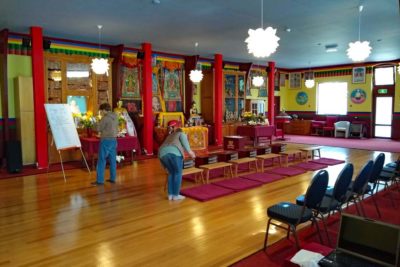
“Try to see White Manjushri as the embodiment of the wisdom realizing emptiness. We need to know about our afflictions, what they are, and what the biggest one is. We need to know how to use different techniques to solve our problems. Mahamudra says phenomena lack natural existence. We need to remember that everything arises from causes and conditions.
The ‘I’ is merely designated in dependence upon the aggregates and is not fixed and permanent. If we analyze, our wrong concepts will start to fall away, and we can give rise to a stronger and stronger understanding of emptiness. It is a gradual process, like the sun coming up in the morning.
Try to break through old patterns of thinking, like neurosis, when we’re grabbing at a self. We worry, develop attachment, etcetera. Developing an understanding of emptiness helps to avert these non-productive states of mind. See the temporary benefits of applying the antidotes to your afflictions and cultivating an understanding of emptiness and then recognize these benefits and grow them. Be discerning about what works for you.”
The focus of Mahamudra teachings is the lack of natural existence of the mind
“There are two potential pitfalls. The first is nihilism, thinking that nothing exists. You need to do an analytical meditation to disprove your erroneous ideas. The second is reification, making something abstract into something real, like we do with our anger and attachment. We need to remember dependent arising, that everything arises from causes and conditions.
In Mahamudra, the main practice is meditation on the true nature of mind.
The different schools of Buddhism, Nyingma, Gelug, Sakya and Kagyu have different approaches, but the final conclusion of no natural existence of the mind is the same for all four schools.”
In Mahamudra, motivation is particularly important
“In Mahamudra, motivation is particularly important. The motivation is to be able to realize the mind’s luminous nature and lack of inherent existence. It’s a very specific motivation.”
The Buddhas have recognized this nature and we haven’t. That’s all!

“We remind ourselves that all beings have the tathagatagarbha, or the nature of pure luminosity. This luminosity is the same for us and for the Buddha’s. The only difference is that the Buddha’s have recognized this nature and we haven’t. That’s all!”
“Our positive mental qualities point to our true nature, this pure luminosity. Attachment and anger have no firm basis. They are not connected to minds true nature. Try to look at these afflictions as uninvited guests.”
In Tantra we’re looking at the world through different eyes
“In the sutra teachings, we look with honest eyes at ourselves and our imperfections and apply the antidotes. In Tantra we’re working a bit differently. Because it’s different it’s known as Secret Mantra. It is a jump in our thinking. We’re looking at the world through different eyes.”
“We want to imagine that we’re the Buddha. We’re creating causes for that to happen in the future. We want a sincere imagination when thinking ‘I am the deity’. We need divine pride. We also imagine that we experience great bliss. Ordinary and holy beings experience the world in different ways. Totally different. The way to approach is to study. Through the study and understanding of the path, we’ll increase our confidence.”
The Four Key Points of Mahamudra
- Unwavering focus or meditation on our object of meditation with single pointed concentration
- Pacification of obstacles or hindrances and the purification of obscurations
- Accumulation of merit or conducive conditions
- Heartfelt requests to the deity, remembering as inseparable from the Guru
“Because Buddha’s mind is free, whenever we call on him, he is there. He can be at all places at all times. It is important to counter our obscurations and negativities. We have to deal with namtok, or false thinking. There is no other pathway other than realizing things as they are.”
Remember, your mind and the deity’s mind are the same!
“Slowly, slowly we will be able to develop the qualities we seek. We establish causes to continue our practice in our next life. Remember, your mind and the deity’s mind are the same. They’re both empty! The sphere of emptiness is within the mind.”
“With Kriya Tantra we transform ordinary body, speech and mind into the holy body, speech and mind of a Buddha.”
Geshe Sonam Ngodrup gave the oral transmission of the White Manjushri mantra, Om Va Kye Dam Na Mah, and offered the following explanation:
White Manjushri mantra
|
Om |
Offering holy body, speech and mind |
|
Va |
Through the propounding of truth, all obstacles are cleared away. Roar of truth of Dharma |
|
Kye |
The holy beings rejoice in the truth being propounded |
|
Dam |
The accumulation of all good fortune through the merit of Dharma being propounded and by rejoicing |
|
Na |
The White Manjushri mantra is the supreme mantra |
|
Ma |
Manjushri himself, as if you were calling him |
Dedication
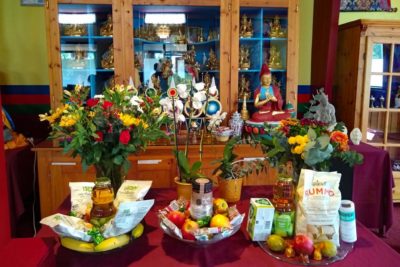
“You should always dedicate the positive merit or energy from any positive activity. This is like putting money in the bank for the future. Your should rejoice and have a heartfelt appreciation for the action.
We’ll gradually be able to include more and more sentient beings in our dedications. You can dedicate to your own or others long life. Then you rejoice. Rejoicing is an antidote to envy and jealousy. I think also pride. Please don’t forget to dedicate. It is very important. The final prayers of the day in the monastery are always prayers of dedication.”
Special advice for the home practitioner & initiates
“To recite the sadhana or to visualize the self-generation is not appropriate for the home practitioner because initiation is required.”
“However, One can recite the Mantra and visualize lights and nectar entering One’s body from a visualized Manjushri above the crown of One’s head. This you can do without the initiation.”
“If one has received a great initiation, when one receives a tenant one is allowed to do the self-generation. If one has NOT received a great initiation, one can practice the crown-generation (visualizing the Buddha above the crown of one’s head) after receiving the Jenang.”
Beings of this time have a special capacity for Tantra
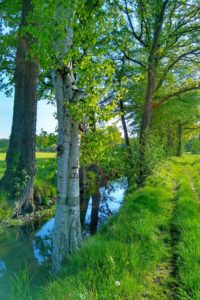
“As times degenerate, Orange Manjushri becomes less powerful and White Manjushri becomes more powerful, and it is through the Mahamudra that we can realize ultimate nature by activating our clear light potential.”
“Beings of this time have a special capacity for Tantra. You can see this. Lamas all over the world are giving Tantric initiations. His Holiness the Dalai Lama gives many Tantric initiations and frequently talks about Tantra.”
“What causes unsteadiness of mind? Thoughts which we endlessly follow. The mind is a mirror. The objects we place on it, all our discursive thoughts, cloud the mirror! We need to see the pattern and then try to remove. Which thoughts are wholesome and useful, which are not? It’s a natural process. We’re aware of what’s going on in our mind. Mindfulness of the true nature of mind is emptiness.”
“Without Tantra we cannot activate the extremely subtle mind that meditates on emptiness. We study Tantra now in order to practice it in the future. We have this hidden treasure in our mind, and we need to discover its true nature. Use your intelligence to think about reality. You will benefit and reach a calmer state!”
Advice for everyone
“Try to start the day with a meditation on love, compassion and emptiness.” His Holiness the Dalai Lama says an understanding cultivated at the beginning of the day helps us to deal with the rest of the day, whatever happens, good or bad. His Holiness says often, “you are your own master, you are your ultimate guru.”
Final thoughts
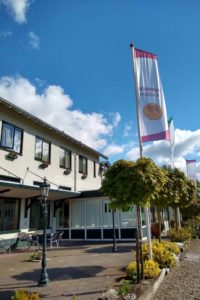
At one point in the retreat Geshe Ngodrup compared the visualizing of the Buddha Manjushri to a child dreaming of growing up and becoming President.
I grew up in the suburbs of the US capital, and like many Americans of my baby boomer generation, I too had this long-forgotten dream as a child. That dream carried me through my childhood and gave my imagination wings. Those dreams gave me the conviction that I could achieve anything I put my mind to. Those dreams gave my life purpose and direction. It’s time to remember those dreams again.
I was inspired to see my precious teacher again after two years of absence. I was inspired by his instructions. I was inspired by my fellow retreatants, who just like me, came to have their Dharma Waters replenished by a simple, loving Tibetan Buddhist master.
I got a great deal from my one week, including the inspiration for my daily practice, and most importantly, the courage to dream again. Why not be a Buddha I now ask myself? Without dreams the human spirit cannot thrive. So why not dream BIG?
Notes
[1] Source: White-Manjushri
[2] Source: a-meditation-on-orange-manjushri

